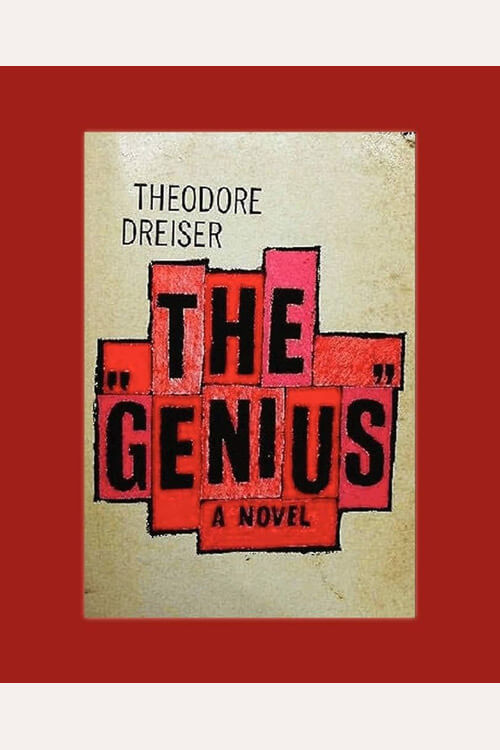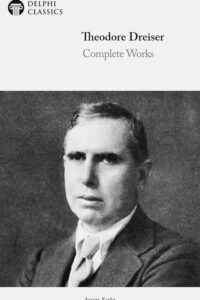
The ”Genius”
The “Genius” is a semi-autobiographical novel by Theodore Dreiser, first published in 1915. The story concerns Eugene Witla, a talented painter of strong sexual desires who grapples with his commitment to his art and the force of his erotic needs. The book sold 8,000 copies in the months immediately following publication but encountered legal difficulties when it was declared potentially obscene. Dreiser’s publisher was nervous about continuing publication and recalled the book from bookstores, and the novel did not receive broad distribution until 1923. When The “Genius” was reissued by a different publisher, the firm of Horace Liveright, it immediately sold more than 40,000 copies. The novel is divided into three sections: “Youth,” “Struggle,” and “Revolt.”
In Book I, Eugene Witla (like Sister Carrie in Dreiser’s earlier novel) escapes the confines of the small Illinois town where he was raised to make his way in Chicago. There, he studies painting at the Chicago Art Institute and enjoys the excitement of the city and his first sexual experiences. He becomes engaged to a young woman, Angela Blue, with whom he is intimate before their marriage, but he finds it difficult to remain faithful at all times. A life based on monogamy seems beyond him.
In Book II, Eugene and Angela move to New York City, where he makes a name for himself in the art world as an urban realist but finds his marriage with the increasingly conventional Angela painfully limiting. They travel to Europe, and he suffers a breakdown. They return to New York, where Eugene attempts to make a better living in advertising.
Book III chronicles the deterioration of Eugene and Angela’s marriage as he begins an affair with Suzanne Dale, the teenage daughter of a woman who works in the same office (this affair is one of the most autobiographical details in the book); Suzanne’s mother and Angela do everything they can to end the relationship but to no avail. In one scene, Angela, pregnant, comes upon her husband in bed with his teenage girlfriend. Angela dies in childbirth, but her demise does not free Eugene to be with Suzanne. He ends the story alone, a man who has never been able to control his lust and is uncertain of what used to put his talents into taking care of his newborn daughter.
Read or download Book
Theodore Dreiser
Theodore Herman Albert Dreiser (August 27, 1871 – December 28, 1945) was an American novelist and journalist of the naturalist school.
Biography
His novels often featured main characters who succeeded at their objectives despite a lack of a firm moral code and literary situations that more closely resemble studies of nature than tales of choice and agency. Dreiser’s best-known novels include Sister Carrie (1900) and An American Tragedy (1925). In 1892, Dreiser started work as a reporter and drama critic for newspapers in Chicago, Saint Louis, Toledo, Pittsburgh and New York. During this period, he published his first work of fiction, The Return of Genius, which appeared in the Chicago Daily Globe under the name Carl Dreiser. By 1895, he had been writing articles for magazines. He authored articles on writers such as Nathaniel Hawthorne, William Dean Howells, Israel Zangwill, and John Burroughs. He interviewed public figures such as Andrew Carnegie, Marshall Field, Thomas Edison, and Theodore Thomas. His other interviewees included Lillian Nordica, Emilia E. Barr, Philip Armour, and Alfred Stieglitz.
In 1895, Dreiser convinced business associates of his songwriter brother Paul to give him the editorship of a magazine called Ev’ry Month, in which he published his first story, “Forgotten”, a tale based on a song of his brother’s titled “The Letter That Never Came”. Dreiser continued editing magazines, becoming editor of the women’s magazine The Delineator in June 1907. As Daniels noted, he thereby began to achieve financial independence. Dreiser claimed to have collected such stories every year between 1895 and 1935. He based his novel on details and the setting of the 1906 murder of Grace Brown by Chester Gillette in upstate New York, a crime that attracted widespread attention from newspapers. While the novel sold well, it also was criticized for its portrayal of a man without morals who commits a sordid murder. Though known primarily as a novelist, Dreiser also wrote short stories, publishing his first collection of 11, entitled Free and Other Stories, in 1918.
His story “My Brother Paul” was a biography of his older brother, Paul Dresser, who became a famous songwriter in the 1890s. This story formed the basis for the 1942 romantic movie My Gal Sal. Dreiser also wrote poetry. His poem “The Aspirant” (1929) continues his theme of poverty and ambition: a young man in a shabbily furnished room describes his own and the other tenants’ dreams and asks, “Why? Why?” The poem appeared in The Poetry Quartos, collected and printed by Paul Johnston and published by Random House in 1929.






